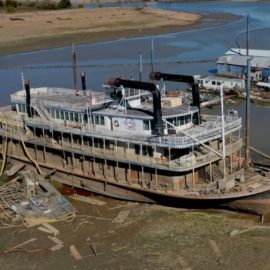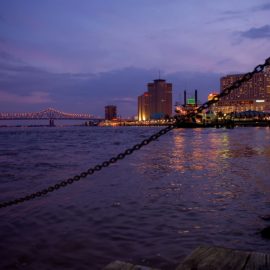
(Photo courtesy of Weeks Marine Inc.)
Tuesday a dredge started building a levee under the River to block the salt water that is coming up. The river is low.
A dredging company began construction on Tuesday of a 1,500-foot-wide underwater levee designed to block a wedge of Gulf of Mexico saltwater from reaching public and industrial water supply intakes on the Mississippi River in Plaquemines Parish and New Orleans. The Army Corps of Engineers announced Wednesday that Weeks Marine Inc., which has a regional office in Covington, has moved its JS Chatry dredge and associated barges and pipelines into place just north of the Phillips66 Alliance Refinery site. From there, the company will dredge sediment from the bottom of the river and pump it to a location near Myrtle Grove to build the underwater structure, known as a “sill.” Corps officials declined to disclose the price of the dredging contract on Wednesday, but last week estimated the project would cost about $10 million.
nola.com
The river is about 90 feet deep at the site.
The river at the Myrtle Grove location is around 90 feet deep, and the wide earthen structure could rise as much as 45 feet from the river’s bottom. That could require ocean-going vessels, which often have 50-foot drafts, to reduce the amount of cargo they are holding, or to unload part of the cargo south of the sill, in order to avoid running aground on it or damaging it. The U.S. Coast Guard and the Corps said they are coordinating with vessel operators to assure the sill construction’s effects on shipping are limited. Saltwater is moving up the river from the Gulf of Mexico because of a lack of rainfall this spring, summer and fall in the upper Mississippi, Ohio and Missouri river valleys. The Mississippi’s low flow is allowing saltwater to creep slowly upriver beneath the river’s fresh water. On Tuesday, the Corps estimated the leading “toe” of the saltwater wedge was already at mile marker 57.2, but said the higher part of the wedge that could cause problems for water intakes was about 20 miles farther south. “Throughout the construction phase, the Corps will test salinity levels in the river to determine where the saltwater wedge is and how high the sill may need to be built,” according to a Corps news release.

(Photo courtesy of Weeks Marine Inc.)
Salt water has already reached a water intake.
Saltwater has reached a Plaquemines water plant in Boothville, and will eventually reach one in Pointe a la Hache, both of which are south of the sill. A drinking water advisory is already in effect for residents using water from the Boothville facility because of high levels of sodium and chlorate in the water. Plaquemines Parish officials have not yet announced whether reverse osmosis water treatment units it was trying to lease have arrived for installation at the two lower river water plants.



